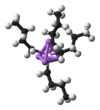N-BuLi
|
|||
 Close-up of the delocalized bonds between butyl and lithium
|
|||
| Names | |||
|---|---|---|---|
|
IUPAC name
butyllithium, tetra-μ3-butyl-tetralithium
|
|||
| Other names
NBL, BuLi,
1-lithiobutane |
|||
| Identifiers | |||
|
3D model (JSmol)
|
|||
| ChEBI | |||
| ChemSpider | |||
| ECHA InfoCard | 100.003.363 | ||
|
PubChem CID
|
|||
|
|||
|
|||
| Properties | |||
| C4H9Li | |||
| Molar mass | 64.06 g·mol−1 | ||
| Appearance | colorless liquid unstable usually obtained as solution |
||
| Density | 0.68 g/cm3, solvent defined | ||
| Melting point | −76 °C (−105 °F; 197 K) (<273 K) | ||
| Boiling point | decomposes | ||
| Reaction | |||
| Solubility | Diethyl ether, cyclohexane | ||
| Acidity (pKa) | 50 | ||
| Structure | |||
| tetrameric in solution | |||
| 0 D | |||
| Hazards | |||
| Main hazards | pyrophoric (inflames in air), decomposes to corrosive LiOH |
||
| NFPA 704 | |||
| Related compounds | |||
|
Related organolithium
reagents |
sec-butyllithium tert-butyllithium hexyllithium methyllithium |
||
|
Related compounds
|
lithium hydroxide | ||
|
Except where otherwise noted, data are given for materials in their standard state (at 25 °C [77 °F], 100 kPa).
|
|||
|
|
|||
| Infobox references | |||
n-Butyllithium (abbreviated n-BuLi) is an organolithium reagent. It is widely used as a polymerization initiator in the production of elastomers such as polybutadiene or styrene-butadiene-styrene (SBS). Also, it is broadly employed as a strong base (superbase) in the synthesis of organic compounds as in the pharmaceutical industry.
Butyllithium is commercially available as solutions (15%, 25%,1.5 M, 2 M, 2.5 M, 10 M, etc.) in alkanes such as pentane, hexanes, and heptanes. Solutions in diethyl ether and THF can be prepared, but are not stable enough for storage. Annual worldwide production and consumption of butyllithium and other organolithium compounds is estimated at 1800 tonnes.
Although butyllithium is colorless, n-butyllithium is usually encountered as a pale yellow solution in alkanes. Such solutions are stable indefinitely if properly stored, but in practice, they degrade upon aging. Fine white precipitate (lithium hydroxide) is deposited and the color changes to orange.
n-BuLi exists as a cluster both in the solid state and in a solution. The tendency to aggregate is common for organolithium compounds. The aggregates are held together by delocalized covalent bonds between lithium and the terminal carbon of the butyl chain. In the case of n-BuLi, the clusters are tetrameric (in ether) or hexameric (in cyclohexane). The cluster is a distorted cubane-type cluster with Li and CH2R groups at alternating vertices. An equivalent description describes the tetramer as a Li4tetrahedron interpenetrated with a tetrahedron [CH2R]4. Bonding within the cluster is related to that used to describe diborane, but more complex since eight atoms are involved. Reflecting its "electron-deficient character," n-butyllithium is highly reactive toward Lewis bases.
...
Wikipedia



